Here you will find my favourite 2 home-made glue recipes: Tacky Gelatin Glue and Corn starch glue/paste.
I have used corn starch glue quite a bit and have really liked the results. But my new favourite is gelatin glue! It is a bit more of a hassle to use once it has cooled down, because you have to reheat it (easily done under running hot water) and keep reheating it as you go.
I have used both of these to make my paper straws and they both work very well. If I had to choose between the two, though, I would choose the Tacky Gelatin Glue. But then, I’m not a vegetarian…
Both these glues are perfect for Making Your Own Paper Drinking Straws. They stick hard and fast, they are edible and they are cheap!
Tacky Glue (Gelatin Glue)
This glue dries clear(ish). You will notice a very slight yellow tinge. But this doesn’t matter when using it for labels or stickers, does it :)
Ingredients
- 1 packet of unflavoured Gelatin** (I recommend Knox, available HERE from Amazon)
- 4 tbsp water (3 of which should be boiling)
- 1 tbsp white vinegar (you can use malt vinegar, but you’ll get brownish glue)
- 1 tsp glycerin
** 1 packet of Gelatin is equal to 7 g, 1/4 oz, or 1 tbsp
Method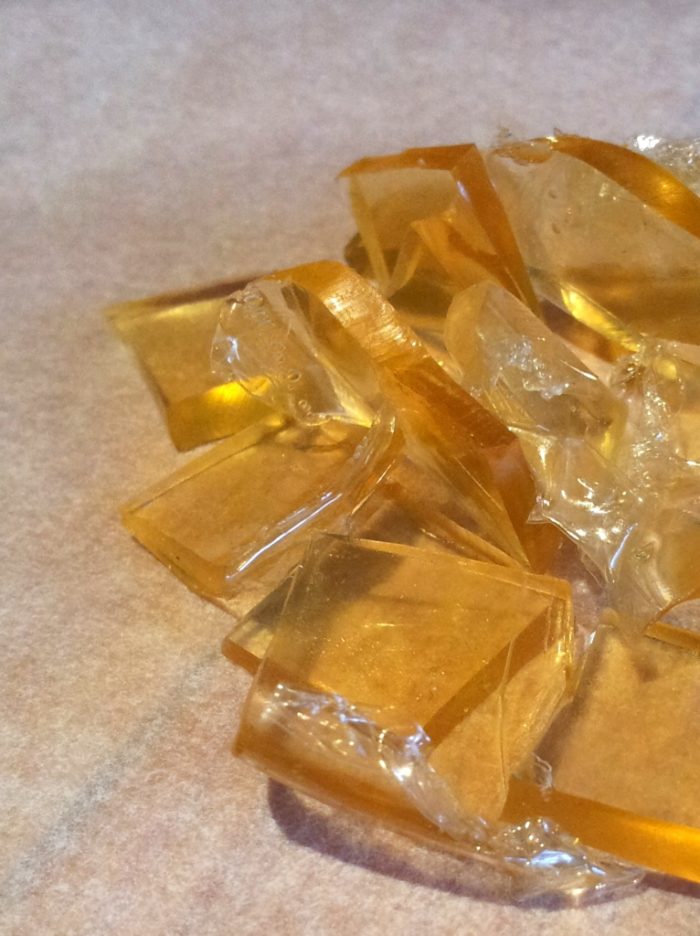
- Let gelatin bloom in 1 tbsp cold water
- Add 3 tbsp boiling water, vinegar and glycerin and stir to dissolve. I found that a few 5 sec blasts in the microwave helped this along. You could also put it in a pot on the stove if you felt it needed a bit of help.
- Once made, store in an airtight container.
“Oh no! My glue has become a solid lump!”
It’s ok. That’s what gelatin does. To get the glue gloopy again, place the whole container under hot running water or zap in the microwave (without a lid) for a few seconds. It will become nice and runny again.
If you want to save yourself some hassle, just leave the gelatin in the pot/cup (whatever you used to make it in) to set. Once set, remove from the pot and cut up with a pair of scissors. When you need to use some of it, just place a few shards and a few drops of water in a microwavable bowl and blast for 5 sec at a time until melted. Waaaay easier than getting the whole pot wet every time. Especially if you go to all the trouble of putting on a label.
This glue is AWESOME for labelling as it keeps the label stuck on, but also peels off super easily when you want the label gone. And if you decide that you didn’t actually want the label gone, just lick the glue side and stick it back on. Apply a little bit of pressure and you’re set. I’ve repeated the whole process 5 or 6 times with my little glue label and it is still sticking strongly after being removed and re-applied that many times.
Uses
- Stick labels to glass jars semi-permanently
- Make stickers by printing out pictures/cutting them from magazines and coating the back with this tacky glue. Let dry and lick when ready to use. (Takes about 24 hours to dry completely, but can be lick-and-sticked before then.)
- Stick paper to paper/cardboard/wood quite thoroughly!!!
Corn Starch Glue/Paste
This glue dries completely clear and is merrily vegetarian – even vegan!
Ingredients
- 30 ml corn starch
- 120-150 ml cold water
- 1 tbsp white vinegar
This is the ratio if you want to make more or less:
- 1 part corn starch
- 4-5 parts water
- 1 ml white vinegar for every 10 ml water (roughly)
Method
- In a saucepan: make a paste with the corn starch and 30 ml of the water (to avoid lumps later on). Add the rest of the water and stir constantly over a low heat. When the mixture starts firming up, remove from the heat for a second and beat quite vigorously with a wooden spoon.
- Return to the heat and heat (stir stir stir!) until the mixture is the consistency and colour of Vaseline.
- Remove from the heat and add the vinegar. When it has cooled sufficiently, stir stir stir again before popping it into your airtight container. This will make it a bit more pastey again.
Note: A lot of recipes call for 3 parts water for every 1 part of corn starch, but I find the resulting paste to be more bouncy ball than glue. Go with your gut. If you are concerned that the 1:5 ratio will be too liquid (IT WON’T), add 3 parts water to begin with and then add more if you need it (YOU WILL). You can always add more later. You can’t really add less later.
Uses
- Stick labels to glass jars semi-permanently
- Make stickers by printing out pictures/cutting them from magazines and coating the back with this tacky glue. Let dry and lick when ready to use. (Takes about 24 hours to dry completely, but can be lick-and-sticked before then.)
- Stick paper to paper/cardboard/wood quite thoroughly!!!

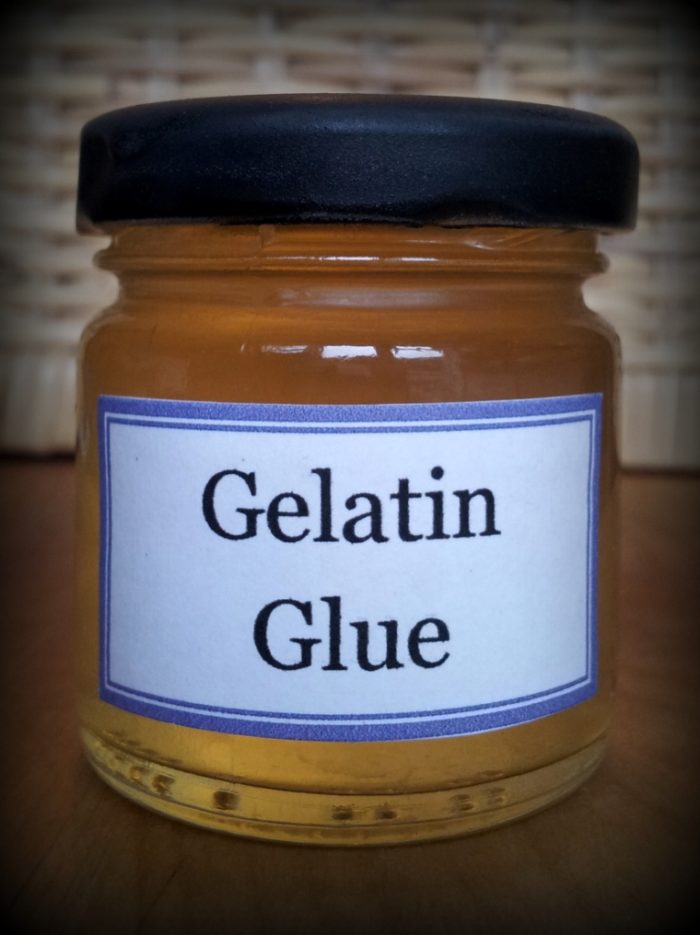
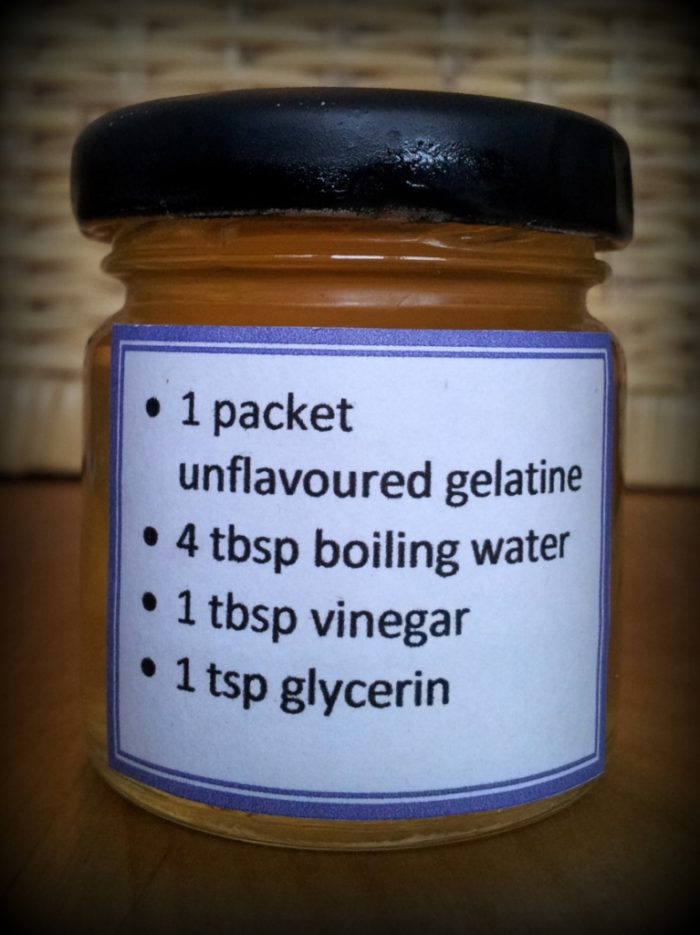
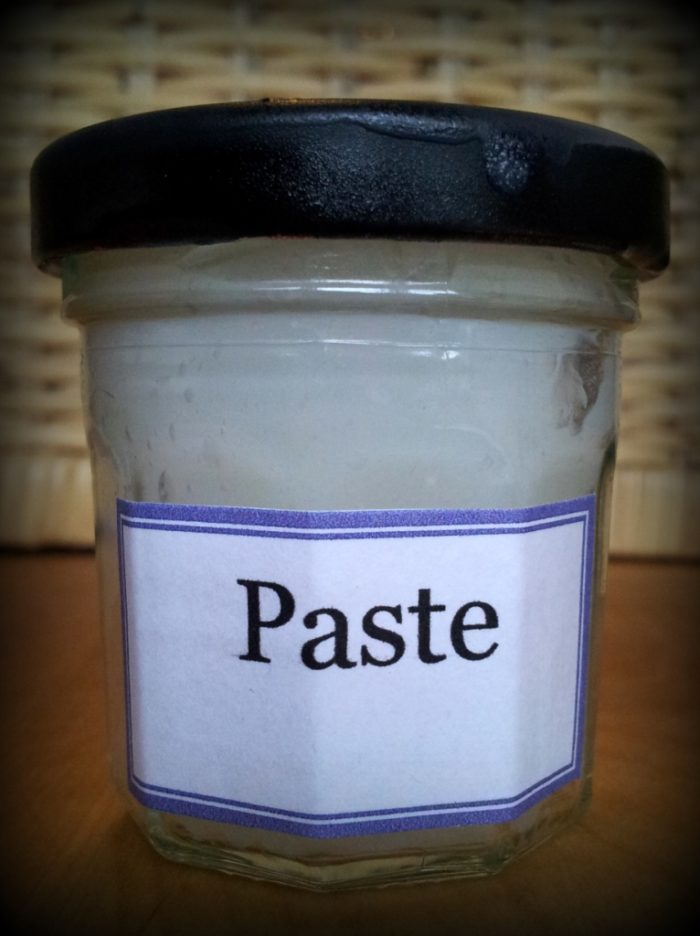
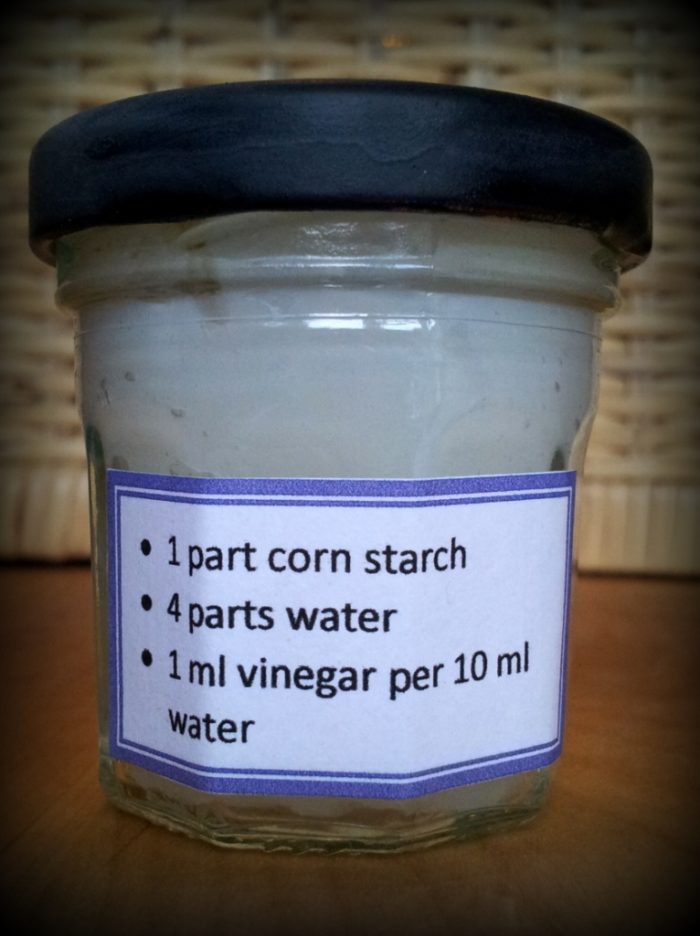
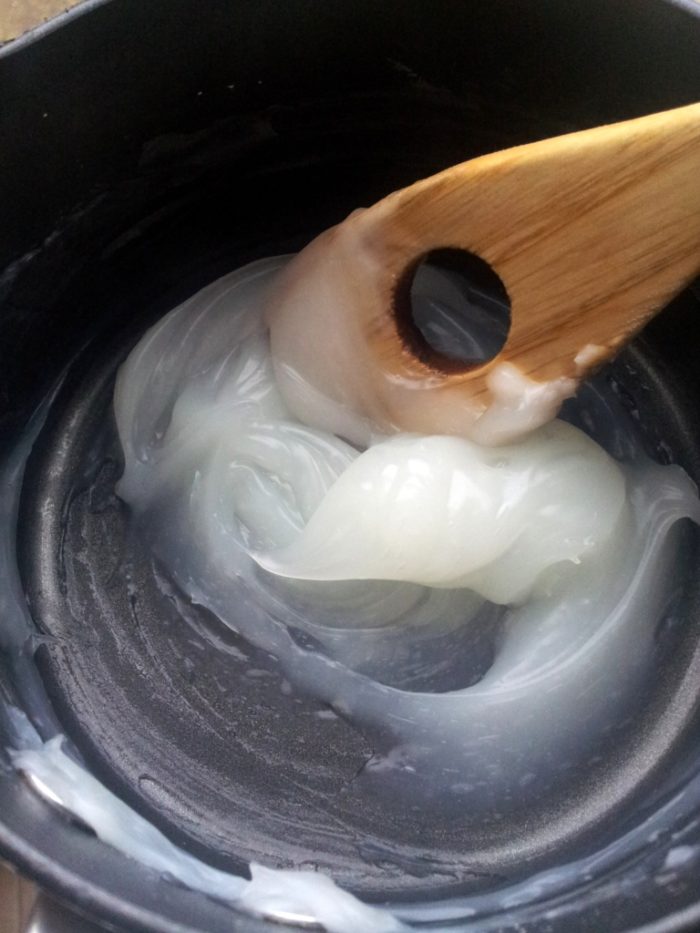



Shweta says
Hi!
Thank you so much for theglue recipe.Its very useful! I have only two questions in mind:
1)The glycerine glue emits a foul smell, how can I reduce the smell?
2) The glue is slightly acidic in nature, how to makeit itno alkaline so that i can stick a bunch of ‘acid free’ papers together with outspoiling them (for long term)
Please reply! And thanks again !
Dedri Uys says
Hi. I have not found the gelatine glue to have a foul smell. If you do not like the smell of gelatine, I suggest using the cornstarch glue instead. If you don’t like the acidic nature of the glue, omit the vinegar. If you do leave out the vinegar, though, the glue might not last as long once made.
Don Gato says
why the use of glycerin?
Dedri Uys says
Hi Don. The glycerine acts as a plasticizer. It keeps the glue soft and flexible (once heated up again).
Rhonda says
I made the cornstarch glue last night and it is a solid blob now. Would adding water do the job to thin it out to use?
Dedri Uys says
Rhonda, once it has set it is not possible to break it up again. I have not had it set on me using the quantities specified. I would be interested to know if you have any suggestions?
DD says
Hi! Love your website so much.. Anyways which glue type is safe for kids skin? I really need to know…. Thanks if your reply ! ~~~ DD omgomgomgomgomgo ( cough ) gomomgomgomgomg o)
Jenny says
Hello DD. Can you say what you want to use the glue for exactly? I would say the lick and stick paste glue is skin friendly as it is stated as being lick-and-stickable, but it is always good to know what your intended purposes are before commenting completely :)
Theresa says
Hey, Thanks for the useful recipes. Which glue would you recommend to use on the skin? Lets say for fake eye lashes or body glitter?
Dedri Uys says
Hi Theresa. I think the gelatin glue would work better.
N says
Hi Theresa,
I’m thinking of trying the gelatin glue to glue on false lashes. Have you tried it/had any success with it?
Ursula Giles says
When you say a packet of gelatin, how much is that, the unflavoured gelatin I can get here is a 100g packet, I’d use a tablespoon (15mL/14g) in half a cup (100mL) of boiling water to set 400ml of liquid as a jelly. I am assuming that your packet is smaller than that as I wouldn’t even be able to dissolve it all in the liquid in your recipe. please help, I really want to try this along with your metod of waterproofing with the labels for my jars of bath & body stuff that I sell.
Dedri Uys says
Ursula, I have pulled this from the Kraft Website to give you a better idea of how much to use.
“1 pouch is about 2 1/2 teaspoons (7g) unflavoured gelatine. If a recipe calls for 1 tablespoon, use 1 pouch of unflavoured gelatine. Each pouch will gel 2 cups (500mL) of liquid and up to 1 1/2 (375mL) cups of solids.”
If you are using a different kind of gelatin, you want to use the same amount of gelatin you would usually use to set 500 ml of liquid, but using only 4 tablespoons of liquid.
aurora says
I am doing a skull project. I’ve never done this before, but I know I need to seal this thing, and fill in quite a few cracks, as it’s quite old. I was wondering if you knew of any glue that would be ideal for this, feeling hard enough to be passed off as bone. But if all else fails, what is a good glue that I can mix a silvery coloring into? I figure I could make the glue harder than the skull, and a metallic color. But I don’t know what to use!
Dedri Uys says
Hi Aurora. I’m afraid I don’t know the answer to your question. Have you looked into using resin instead of glue?
Lorisa says
another thing you could add to you arsenal of craft adhesives is liquid concentrated laundry starch, It dries clear and hardens pretty well. I use it for string art and paper mache not water proof and takes 12 to 24 hours to dry completely. i do use a clear coat of weather proof sealer if it will be out side for any time
Dedri Uys says
Thanx. I will buy some and give it a try :)
Patel Virendra says
may i know the specification of corn starch do you used?
when i follow your receipe, there will be some lumps in paste when it become cool.
Please suggest specification of paste.
Thanks & Regards,
Virendra
Dedri Uys says
Patel, if your cornstarch paste becomes lumpy when standing, try covering it with cling film while it’s cooling by placing the cling film on the surface of the paste. This should help avoid lumps.
Samuel Vargas says
Hi, I just want to know if your glue can dries solid to create cubes with birds food?
Dedri Uys says
Samuel, the gelatin glue would def work.
Samuel Vargas says
Thanks Dedri. I try to find the Gelatine Glue but I won’t be able to find it. Did you have any idea where I can buy it?
Dedri Uys says
Samuel, you’ll have to make a batch. I am pretty sure you can’t buy gelatin glue…
Willie says
or should i try home made mod podge? which is basically Flour, Sugar, Water and White vinegar?
Dedri Uys says
Hehe, Willie, I was actually going to suggest using “home-made mod podge”. I’ve never made it with sugar and vinegar. I just always use a flour and water paste?
Willie says
Hello! Im building a pepakura model of a helmet and i want to keep it as cheap as possible but look fairly decent.
Im building it out of hard cardboard and Im going to be using home made mod posh and paper mache to get it hard.
I was going to use car body filler for the detailing but my dad says you need hardner for it too and then it becomes expensive.
How easy is it to stack layers of this paste glue to model with if you make it fairly pasty. Also can you sand and paint it?
thanks
Dedri Uys says
Hi Willie, I wish I could say that it will work, but it won’t sorry. The gelatine glue will have the consistency of too-stiff jelly once it has dried and there is no way to sculpt or shape it unless you pour it into an actual mould. You cannot reliably sand/paint it once dried, because it is basically jelly.
Willie says
Ok what if i use the paste only? how hard does that stuff get and how would it work with paper mache?
Dedri Uys says
You can use the cornstarch paste, but in my opinion the flour and water paste works better for papier mache because it soaks into the paper better and is much easier to prepare.
Nicole says
is the gelatin glue edible??
Dedri Uys says
Hi Nicole. It is, yes, but it’s not particularly tasty.
Sandy says
Hello! Could this also be used as an adhesive to the skin such as the back of a breathe right nose strip? Thanks -Sandy
Dedri Uys says
hi Sandy. I am sure you can use the gelatine glue. Not so sure if the cornstarch glue will work. Both are safe for using on your skin though. I might have to go and experiment a bit…
Jay says
Excellent reference that you provided! Thank you. It led to a world of craft book-binding that I never knew existed. I’ll be exploring it in detail. Best wishes.
Jay
Jay says
By the way, after I posted the previous comment, I noted the time difference between Pacific Coast Time and your time: 8 hours. So you are “across the pond.” Then I read your “About.” Given your medical training, you may be interested to know about the books I am repairing. The 1889 volume is Grey’s Anatomy, and I want to give it to my dermatologist, a thoroughly fantastic young woman who became interested in medicine at the age of 8 when she read Grey’s. The second is a 1779 copy of a treatise on electricity by Joseph Priestly. The spine on that volume is cracked. In that book, he refers to work by a “Dr. Franklin,” and others about whom today’s students (I teach chemistry) know virtually nothing. I found your blog by searching for natural glues and I’m glad I did. Thank you for the wisdom you are sharing. I “get” that it is a labor of love and it makes people feel good! Thank you, Dedri!
Jay
Jay says
I am repairing a 1779 and a 1889 book. Some of the pages are damaged and I plan on using onion skin paper pasted over the existing pages to restore them. I will be rebinding the book with leather covers over binder board. My goal is to keep the book as “authentic” as possible. Therefore, I don’t want to use materials from the modern era. For that reason I will use linen thread to resew signatures and linen cloth instead of book-binder tape. My questions are these: Which glues are more flexible, those made from gelatin (hide), starches (corn starch, probably), or albumen (from egg white)? Transparency is critical for coating the pages so my sources would be Knox gelatin, packaged corn starch or organically-grown egg. Next, will these glues tend to crack with age? Since the difference between a “thick” and “thin” layer of glue will only be a few microns, I doubt that thickness of the glue matters. Is that correct, in your opinion? When I apply the glue to the binder-board, the leather and the end papers, do I need to size them first? What is the working time on such applications? Is it a few seconds or several minutes? I am also concerned about paper swelling as I coat with these mixtures. Is that a valid concern? (I do have a little experience in book binding and have a great book on the subject.) Any other hints you may wish to offer will also be appreciated.
Jay
Dedri Uys says
Hi Jay.
Thank you for your query. To tell you the truth, I have only used these glues for crafts that don’t need years and years of survival and I am a bit out of my depth regarding bookbinding and its various glues.
From what I do know, both cornstarch glue AND gelatin glue can be used, although each has its advantages and disadvantages. Of the two I have heard that cornstarch glue would work better for bookbinding and from personal experience I can tell you that it gives you slightly longer working time (although you might have to thin it a bit to give you a good thin glue. And of course thinning it might make it cause the paper to warp very slightly. To combat this, use a very thin layer of glue. And the quicker you attach the layers, the less warping you will get.
I wouldn’t use egg-glue, because the only time I used it it DID crack. Now that might have been my inexperience, but that’s all I’ve got to go on.
As for sizing, I have NO IDEA if you should size them first. BUT…I have bookmarked a website for future reference (because I do still want to bind my own journals) and she has excellent advice on bookbinding. You can find the recipe she advocates here. It is wheat starch glue. I would go for that one if I was you.
I hope this helps a little bit and I am very sorry that I am not more enlightened on the subject.
Your dermatologist is a very lucky woman. What you are planning to do sounds like a real “labour of love”.
Best wishes,
Dedri
NMCREEK says
Is this glue waterproof ..Say someone wanted to make their own Yard Sale,No Trespassing or No Hunting..etc.. Sign and wanted to cover the whole sign with this glue..Would it be protect from the rain?…Thank you for taking the time to put this recipe on line..:)
Dedri Uys says
Hi, because this glue is made from gelatine, it is NOT waterproof. If you use cover your sign with a few coats of varnish, however, it will keep very well.
Rida says
Hey
Thanks so much for the tutorial but with the Cornstarch glue/paste can You use this for adhesive to make tear out books
Dedri Uys says
Rida, I am not exactly sure what you mean by tear-out books. The glue sticks like pva glue, so you won’t be able to peel pages out like post-its.
Phitchaya says
Thank you so much for your recipe. I can’t leave this page without saying Thank You so much for your generous heart because I didn’t know to add vinegar in it.